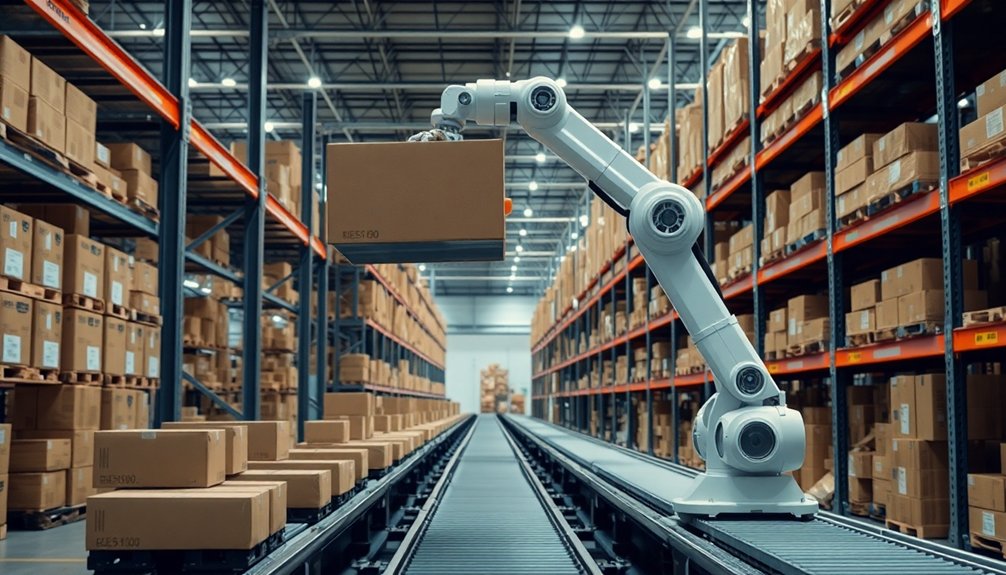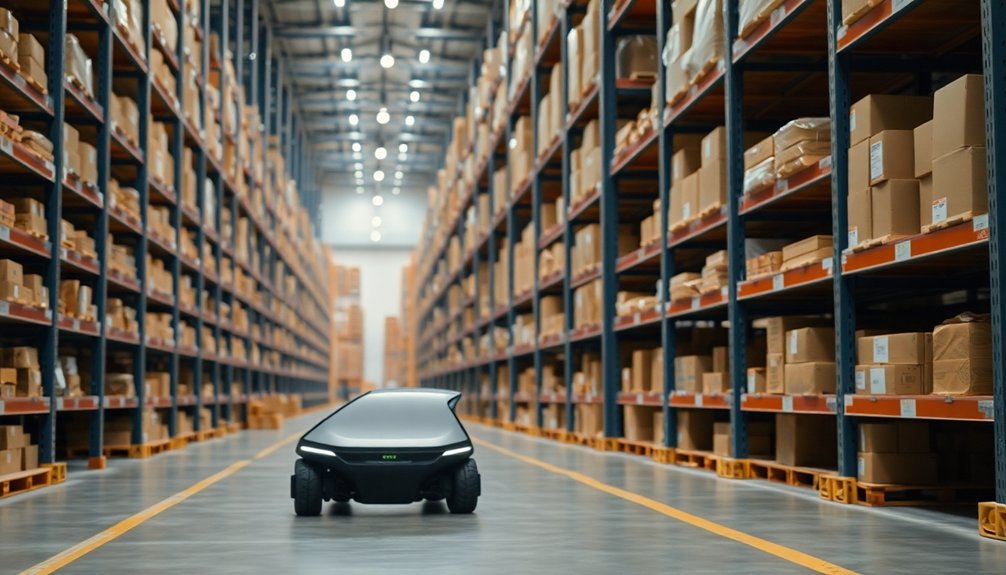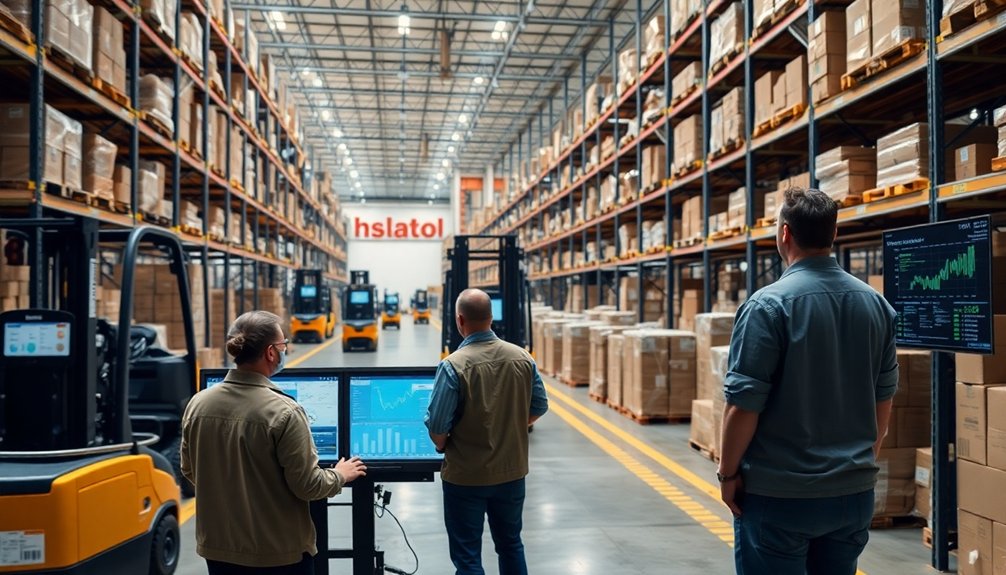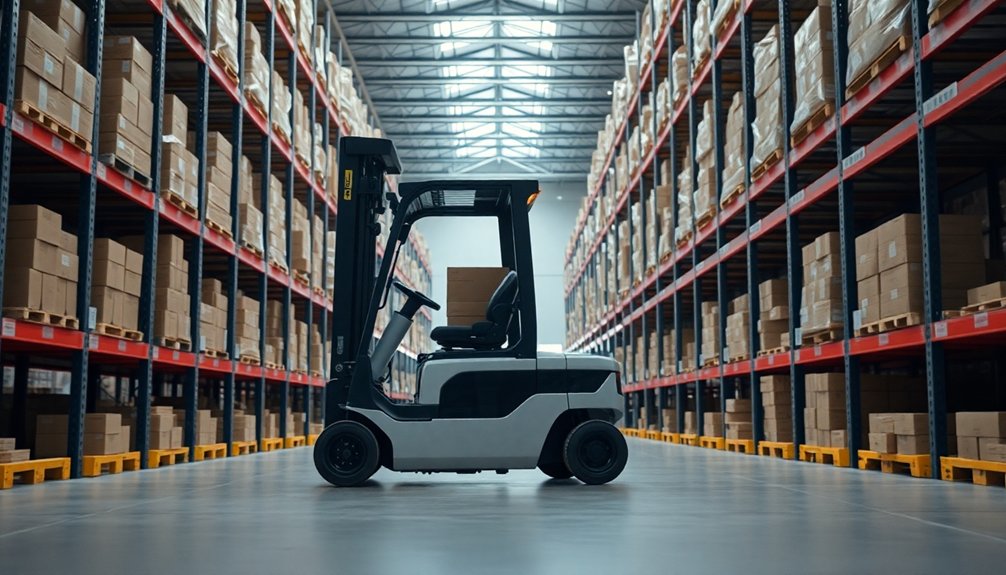Table of Contents
Robots are quietly taking over warehouses, turning dusty storage spaces into lightning-fast logistics machines. You’ll find autonomous robots zipping through aisles, sorting packages with superhuman precision. They’re not just replacing workers—they’re creating smarter jobs, boosting productivity by nearly 30%, and slashing operational costs. Want to know how these silicon-powered workers are rewriting supply chain rules? Stick around, and you might just glimpse the future of work.
The Rise of Warehouse Robotics: A Market Transformation

While the warehouse of yesteryear looked like a human-powered maze of shelves and clipboards, today’s logistics landscape is transforming at robot-speed. With the global warehouse robotics market projected to reach USD 17.98 billion by 2032, market growth accelerates at an unprecedented rate. Picture forklifts and sorting machines giving way to nimble robots zipping between inventory racks, picking and packing with inhuman precision. E-commerce’s explosive growth isn’t just changing shopping—it’s revolutionizing how goods move from warehouse to doorstep.
Why the shift? Labor shortages, skyrocketing wages, and the need for lightning-fast order fulfillment are pushing companies toward automation. Autonomous mobile robots specifically are emerging as a critical solution, with AMR market share growing to 22.3% in the current technological landscape. Advanced sensor technologies are enabling these robots to navigate complex warehouse environments with unprecedented accuracy and efficiency.
Smart warehouses aren’t just cutting costs; they’re rewriting the rules of efficiency. Robots don’t take coffee breaks, make mistakes, or complain about overtime.
They’re the new workforce, turning logistical nightmares into seamless operations—one algorithmic move at a time.
Cutting-Edge Technologies Powering Logistics Automation
As the logistics world shifts gears, cutting-edge technologies are transforming warehouses from static storage zones into dynamic, intelligent ecosystems. Supply chain resilience is now driven by AI-powered systems that anticipate and mitigate potential disruptions before they impact operations. LiDAR and radar technologies enable robots to map environments with superhuman precision, creating detailed 3D point clouds that enhance spatial awareness and navigation through complex warehouse layouts.
Picture robots gliding through aisles like silent ballet dancers, picking and sorting with precision that would make human workers dizzy. AI isn’t just a buzzword—it’s the brain behind predictive analytics that sniffs out potential supply chain hiccups before they happen.
Autonomous mobile robots aren’t replacing workers; they’re freeing them from mind-numbing tasks to focus on strategy. Think of it as workforce augmentation on steroids.
Scalable robotic systems with modular components can adapt faster than you can say “inventory management.” The future isn’t about replacing humans—it’s about creating smarter, more efficient workspaces where technology and human creativity dance in perfect sync. Companies are now investing heavily in robotic automation technologies, with 30% planning to evaluate autonomous mobile robots within the next one to two years.
From Manual to Intelligent: The Adoption of Smart Warehouse Solutions

You’ve seen warehouses evolve from human-powered chaos to robot-driven precision, and it’s about to get even wilder. With mobile robotic systems expanding rapidly – 59% of companies plan to upgrade or implement these technologies in the next two years – the logistics landscape is experiencing a technological metamorphosis. Smart warehouse solutions aren’t just upgrading technology—they’re totally reshaping how logistics work, turning clunky manual processes into lightning-fast, AI-powered workflows. Sensor fusion techniques are helping robots better understand and navigate complex warehouse environments, enhancing their precision and operational capabilities. Think of it like upgrading from a rusty bicycle to a self-driving electric sports car: you’re not just getting from point A to point B faster, you’re fundamentally transforming the entire journey. In fact, modern robotic systems can now achieve unprecedented throughput efficiency, delivering a staggering 400% improvement without requiring additional facility expansion.
Technology Driving Transformation
Because the warehouse of yesteryear looked more like a dusty museum of manual labor, today’s smart facilities are transforming logistics faster than you can say “robot revolution.”
Modern warehouses aren’t just storing stuff—they’re intelligent ecosystems where technology does the heavy lifting, quite literally.
Imagine robots zipping around, grabbing inventory with precision while AI predicts demand before you even know you need something. Mobile robots aren’t just sci-fi fantasies; they’re managing inventory, reducing human error, and making supply chains smoother than a fresh jar of peanut butter. Autonomous robots are reducing manual labor by up to 40%, dramatically improving operational efficiency and precision.
Cloud platforms and IoT technologies have turned warehouses from clunky storage rooms into responsive, data-driven machines that adapt faster than a chameleon changing colors. Companies are now leveraging advanced analytics platforms to gain unprecedented insights into warehouse performance and operational metrics.
Smart Workforce Evolution
When robots started taking over warehouse floors, nobody expected they’d become workforce allies instead of job-stealing monsters. Technological workforce transformation has proven that collaboration, not competition, is the future of human-machine interaction.
Now, they’re transforming how we think about work. Automation isn’t replacing humans; it’s creating smarter roles. Imagine cutting onboarding time in half and reducing mind-numbing manual tasks.
Workers aren’t getting fired—they’re getting upgraded. Training programs are turning warehouse staff into tech-savvy operators who manage autonomous systems. With robotic workforce integration growing from 16% currently to a projected 620,000 annual shipments by 2021, the technological transformation is accelerating rapidly.
Those pallet-moving robots? They’re not taking jobs; they’re making jobs more interesting. With 86% of managers believing automation attracts talent, the future looks like human-machine collaboration. The rise of warehouse automation technologies means that manual tasks consuming 50% of work hours are being systematically transformed into more strategic, engaging roles.
You’re not competing with robots—you’re learning to dance with them. And let’s be real: who wouldn’t want a job where you’re part robot whisperer, part logistics ninja?
Operational Efficiency: How Robots Are Redefining Productivity
As warehouses transform from static storage zones to dynamic productivity powerhouses, robots have become the secret sauce of operational efficiency. These mechanical marvels aren’t just sci-fi fantasies — they’re real game-changers reshaping how work gets done. Reinforcement learning enables robots to continuously improve their performance through trial-and-error training, enhancing their adaptive capabilities.
- Robots boost productivity by 66.67%, turning tedious tasks into lightning-fast operations.
- They slash operational costs by nearly 80%, making bean counters dance.
- Accuracy skyrockets to 99.9%, basically eliminating human error.
- Storage space optimization reaches an mind-blowing 85% efficiency.
- Workplace safety improves dramatically, protecting human workers.
Imagine a world where repetitive tasks vanish and humans focus on creative problem-solving.
Robots aren’t replacing workers; they’re elevating them. By automating mundane processes, these technological teammates free up human potential, transforming warehouses from bland storage facilities into hyper-intelligent productivity machines.
The future isn’t just coming — it’s already here, one robot at a time.
Breaking Down the Economic Impact of Warehouse Automation

Warehouse automation isn’t just another corporate buzzword—it’s an economic revolution transforming how businesses think about productivity and profitability.
Imagine slashing labor costs by 60% while boosting productivity by nearly a third. Robots aren’t stealing jobs; they’re reshaping entire economic landscapes.
By 2026, the warehouse automation market will hit $30 billion, with companies betting big on intelligent systems that work faster, smarter, and cheaper than human counterparts.
AI-powered robots and autonomous mobile systems are turning traditional logistics on its head, making shipping 50% more efficient and storage capacity 50% more flexible.
Want proof? Industrial robot installations are projected to reach 1 million units globally by 2024.
The future isn’t coming—it’s already here, and it’s wearing a metal exoskeleton.
Navigating Challenges in the Robotic Logistics Landscape
Despite the glittering promise of robotic warehouses, the road to automation isn’t just a smooth highway—it’s more like a pothole-riddled construction zone.
You’re maneuvering through a complex terrain where technology meets human potential, and it’s not for the faint-hearted.
Your challenges include:
- Workers wondering if robots will steal their jobs
- Massive upfront costs that make bean counters sweat
- Safety protocols more complicated than rocket science
- Integration headaches that’ll make your IT team cry
- Cybersecurity risks lurking in every connected device
Robotic logistics isn’t about replacing humans—it’s about reimagining how we work.
Technology isn’t a human replacement—it’s a collaborative dance of innovation and potential.
Sure, there are hurdles: AI still stumbles, systems don’t always play nice, and the learning curve is steeper than a Silicon Valley startup’s growth chart.
But for those bold enough to embrace the future, the potential is explosive.
The Future of Warehousing: Emerging Trends and Predictions

While robots mightn’t be taking over the world (yet), they’re definitely reshaping how we move stuff around warehouses.
Imagine this: cobots dancing alongside humans, AI sorting packages faster than you can blink, and AGVs zipping through aisles like high-tech messenger bikes. You’re witnessing a silent revolution where technology isn’t replacing workers, but making their jobs smarter and safer.
IoT sensors track inventory in real-time, augmented reality guides workers through complex tasks, and machine learning predicts maintenance before machines break down.
By 2027, warehouse automation could hit nearly $60 billion—and it’s not just about efficiency. It’s about creating workplaces that are more human-friendly, environmentally conscious, and wildly innovative.
Who said robots can’t be cool?
People Also Ask
Are Warehouse Robots Going to Completely Replace Human Workers?
No, you won’t be entirely replaced. Robots will handle repetitive tasks, but you’ll shift to strategic roles, managing technology, solving complex problems, and performing jobs requiring human creativity and adaptability.
How Much Do Robotic Warehouse Systems Typically Cost?
You’ll find robotic warehouse systems can range from $500,000 to $5 million, depending on scale and complexity. Your costs will vary based on hardware, software, installation, and maintenance requirements for your specific warehouse needs.
Can Small Businesses Afford Warehouse Automation Technologies?
You can afford warehouse automation with government grants, tax credits, and scalable solutions. Start small, focus on key processes, and leverage financial incentives to gradually implement cost-effective robotic technologies that improve your operational efficiency.
What Safety Measures Protect Workers Alongside Robotic Systems?
You’ll stay safe through physical barriers, advanced sensors, emergency stops, and thorough training. Interlocking guard doors, collision detection systems, and strict safety protocols guarantee your protection while robots efficiently work alongside you.
How Quickly Can a Warehouse Transition to Automated Operations?
You’re steering a transformation highway where manual warehouses become automated kingdoms. Depending on your strategy, you’ll typically shift within 18-24 months, with smaller automation tools potentially accelerating your journey to efficiency faster.
The Bottom Line
Robots aren’t just transforming warehouses; they’re rewriting the entire logistics symphony. You’ll witness a silent revolution where cold steel and smart algorithms dance through inventory landscapes, turning human limitations into technological poetry. The future isn’t about replacing workers—it’s about empowering them. These mechanical partners are your new collaborators, turning mundane tasks into strategic opportunities. Will you adapt or be left behind in this electrifying transformation?
References
- https://www.cyngn.com/blog/90-stats-about-logistics-manufacturing-and-automation-you-must-know-2025-edition
- https://www.kardex.com/en-us/blog/warehouse-automation-trends-2025
- https://www.globenewswire.com/news-release/2025/05/16/3083263/28124/en/Warehouse-Robotics-Market-Forecast-Report-2025-2034-117-3-Billion-Opportunity-The-Need-for-Streamlined-Supply-Chains-and-Faster-Delivery-Models-Has-Never-Been-Greater.html
- https://www.capstonelogistics.com/blog/warehouse-operations-trends-2025/
- https://www.omniful.ai/blog/top-warehouse-statistics-industry-trends
- https://www.fortunebusinessinsights.com/warehouse-robotics-market-108713
- https://www.industryarc.com/Report/1284/Warehouse-Robotics-Market-report.html
- https://www.coherentmarketinsights.com/market-insight/warehouse-robotics-market-5056
- https://www.imarcgroup.com/warehouse-robotics-market
- https://www.logisticsmgmt.com/article/2025_outook_survey_warehouse_automation_comes_into_full_focus
